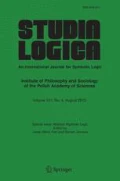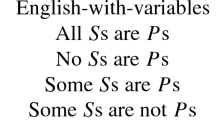Abstract
What is the fundamental insight behind truth-functionality? When is a logic interpretable by way of a truth-functional semantics? To address such questions in a satisfactory way, a formal definition of truth-functionality from the point of view of abstract logics is clearly called for. As a matter of fact, such a definition has been available at least since the 70s, though to this day it still remains not very widely well-known.
A clear distinction can be drawn between logics characterizable through: (1) genuinely finite-valued truth-tabular semantics; (2) no finite-valued but only an infinite-valued truthtabular semantics; (3) no truth-tabular semantics at all. Any of those logics, however, can in principle be characterized through non-truth-functional valuation semantics, at least as soon as their associated consequence relations respect the usual tarskian postulates. So, paradoxical as that might seem at first, it turns out that truth-functional logics may be adequately characterized by non-truth-functional semantics. Now, what feature of a given logic would guarantee it to dwell in class (1) or in class (2), irrespective of its circumstantial semantic characterization?
The present contribution will recall and examine the basic definitions, presuppositions and results concerning truth-functionality of logics, and exhibit examples of logics indigenous to each of the aforementioned classes. Some problems pertaining to those definitions and to some of their conceivable generalizations will also be touched upon.
Similar content being viewed by others
References
Avron Arnon: ‘A nondeterministic view on nonclassical negations’. Studia Logica 80, 159–194 (2005)
Avron, Arnon, ‘Non-deterministic semantics for families of paraconsistent logics’, in Béziau et al. [4], pp. 285–320.
Avron Arnon, Iddo Lev: ‘Non-deterministic multiple-valued structures’. Journal of Logic and Computation 15, 241–261 (2005)
Béziau, Jean-Yves, Walter Carnielli, Dov Gabbay, (eds.) Handbook of Paraconsistency, vol. 9 of Studies in Logic, College Publications, 2007.
Caleiro, Carlos, Paula Gouveia, and Jaime Ramos, ‘Hierarchical logical consequence’, Preprint, SQIG - IT and IST - TU Lisbon, 1049-001 Lisboa, Portugal, 2007. Submitted for publication.
Caleiro, Carlos, Walter Carnielli, Marcelo E. Coniglio, and João Marcos, ‘Two’s company: “The humbug of many logical values”’, in J.-Y. B´eziau, (ed.), Logica Universalis, Birkhäuser Verlag, Basel, Switzerland, 2005, pp. 169–189. Preprint available at: http://wslc.math.ist.utl.pt/ftp/pub/CaleiroC/05-CCCM-dyadic.pdf.
Caleiro Carlos, Walter Carnielli, Marcelo Coniglio, Amílcar Sernadas, Cristina Sernadas: ‘Fibring non-truth-functional logics: Completeness preservation’. Journal of Logic, Language and Information 12(2), 183–211 (2003)
Caleiro, Carlos, and João Marcos, ‘Classic-like analytic tableaux for finitevalued logics’, in H. Ono, M. Kanazawa, and R. de Queiroz, (eds.), Proceedings of the XVI Workshop on Logic, Language, Information and Computation (WoLLIC 2009), held in Tokyo, JP, June 2009, vol. 5514 of Lecture Notes in Artificial Intelligence, Springer, 2009, pp. 268–280. Preprint available at: http://wslc.math.ist.utl.pt/ftp/pub/CaleiroC/09-CM-ClATab4FVL.pdf.
Carnielli, W. A., M. E. Coniglio, D. Gabbay, P. Gouveia, and C. Sernadas, Analysis and Synthesis of Logics: How To Cut And Paste Reasoning Systems, vol. 35 of Applied Logic, Springer, 2008.
Carnielli, Walter A., ‘Possible-translations semantics for paraconsistent logics’, in D. Batens, C. Mortensen, G. Priest, and J. P. Van Bendegem, (eds.), Frontiers of Paraconsistent Logic, Proceedings of the I World Congress on Paraconsistency, held in Ghent, BE, July 29–August 3, 1997, Research Studies Press, Baldock, 2000, pp. 149–163.
Carnielli, Walter A., and Marcelo E. Coniglio, ‘Splitting logics’, in S. Artemov, H. Barringer, A. Garcez, L. Lamb, and J. Woods, (eds.), We Will Show Them! Essays in Honour of Dov Gabbay, vol. 1, College Publications, 2005, pp. 389–414.
Carnielli, Walter A., Marcelo E. Coniglio, and João Marcos, ‘Logics of Formal Inconsistency’, in D. Gabbay, and F. Guenthner, (eds.), Handbook of Philosophical Logic, vol. 14, 2nd edn., Kluwer, 2007, pp. 1–93. Preprint available at: http://wslc.math.ist.utl.pt/ftp/pub/MarcosJ/03-CCM-lfi.pdf.
Carnielli, Walter A., and João Marcos, ‘A taxonomy of C-systems’, in W. A. Carnielli, M. E. Coniglio, and I. M. L. D’Ottaviano, (eds.), Paraconsistency: The Logical Way to the Inconsistent, Proceedings of the II World Congress on Paraconsistency, held in Juquehy, BR, May 8–12, 2000, vol. 228 of Lecture Notes in Pure and Applied Mathematics, Marcel Dekker, 2002, pp. 1–94. Preprint available at: http://wslc.math.ist.utl.pt/ftp/pub/MarcosJ/02-CM-taxonomy.pdf.
Cignoli, Roberto L., Itala M. L. D’Ottaviano, and Daniele Mundici, Algebraic Foundations of Many-Valued Reasoning, vol. 7 of Trends in Logic, Kluwer, Dordrecht, 1999.
Curry Haskell B.: Foundations of Mathematical Logic. McGraw-Hill, New York (1963)
da Costa Newton: ‘On the theory of inconsistent formal systems’. Notre Dame Journal of Formal Logic 11, 497–510 (1974)
Dugundji James: ‘Note on a property of matrices for Lewis and Langford’s calculi of propositions’. The Journal of Symbolic Logic 5, 150–151 (1940)
Font, Josep M., and Ramon Jansana, A general algebraic semantics for sentential logics, vol. 7 of Lecture Notes in Logic, Springer-Verlag, Berlin, 1996.
Gödel, Kurt, ‘Zum intuitionistischen Aussagenkalkül’, Anzeiger Akademie der Wissenschaften Wien, mathematisch-naturwissenschaftliche Klasse, 69 (1932), 65–66. Reprinted in Ergebnisse eines mathematischen Kolloquiums, 4.
Hardegree Gary M.: ‘Completeness and super-valuations’. Journal of Philosophical Logic 34(1), 81–95 (2005)
Jaśkowski, Stanisław, ‘Recherches sur le systéme de la logique intuitionniste’, in Actes du Congrès Internationale de Philosophie Scientifique, vol. 6 (Philosophie des math‘ematiques), Hermann, Paris, 1936, pp. 58–61.
Łoś Jerzy, Roman Suszko: ‘Remarks on sentential logics’. Indagationes Mathematicae 20, 177–183 (1958)
Łukasiewicz Jan, Alfred Tarski (1930). ‘Untersuchungen über den Aussagenkalküls’, Comptes Rendus des séances de la Société des Sciences et des Lettres de Varsovie, 23 (1930), 30–50.
Machina, Kenton F., ‘Truth, belief and vagueness’, Journal of Philosophical Logic, 5 (1976), 1, 47–78. Reprinted in R. Keefe and P. Smith (eds.), Vagueness: A Reader, MIT Press, 1997.
Makinson David: ‘Bridges between classical and nonmonotonic logic’. Logic Journal of the IGPL 11(1), 69–96 (2003)
Malinowski Grzegorz: ‘Q-consequence operation’. Reports on Mathematical Logic 24, 49–59 (1990)
Malinowski, Grzegorz, ‘Inferential many-valuedness’, in J. Woleński, (ed.), Philosophical Logic in Poland, Kluwer, Dordrecht, 1994, pp. 75–84.
Marcos, João, Possible-Translations Semantics (in Portuguese), Master’s thesis, State University of Campinas, BR, 1999. http://libdigi.unicamp.br/document/?code=vtls000224326.
Marcos, João, ‘Possible-translations semantics’, in W. A. Carnielli, F. M. Dionísio, and P. Mateus, (eds.), Proceedings of the Workshop on Combination of Logics: Theory and applications (CombLog’04), held in Lisbon, PT, July 28–30, 2004, Departamento de Matemática, Instituto Superior Técnico, 1049-001 Lisbon, PT, 2004, pp. 119–128. July 28–30, 2004, Lisbon, PT. Extended version available at: http://wslc.math.ist.utl.pt/ftp/pub/MarcosJ/04-M-pts.pdf.
Marcos, João, ‘Ineffable inconsistencies’, in Béziau et al. [4], pp. 301–311. Preprint available at: http://wslc.math.ist.utl.pt/ftp/pub/MarcosJ/04-M-ii.pdf.
Marcos, João, ‘Possible-translations semantics for some weak classically-based paraconsistent logics’, Journal of Applied Non-Classical Logics, 18 (2008), 1, 7–28. Preprint available at: http://wslc.math.ist.utl.pt/ftp/pub/MarcosJ/04-M-PTS4swcbPL.pdf.
Marcos, João, and Dalmo Mendonça, ‘Towards fully automated axiom extraction for finite-valued logics’, in W. Carnielli, M. E. Coniglio, and I. M. L. D’Ottaviano, (eds.), The Many Sides of Logic, Studies in Logic, College Publications, London, 2009. Preprint available at: http://wslc.math.ist.utl.pt/ftp/pub/MarcosJ/08-MM-towards.pdf.
Massey Gerald J.: ‘The theory of truth tabular connectives, both truth functional and modal’. The Journal of Symbolic Logic 31, 593–608 (1966)
Odintsov Sergei: ‘On the structure of paraconsistent extensions of Johansson’s logic’. Journal of Applied Logic 3(1), 43–65 (2005)
Priest Graham (2002). ‘Paraconsistent logic’. In: Gabbay D.M., Guenthner F., (eds). Handbook of Philosoph. Logic, vol. 6, 2nd edn. Kluwer, Dordrecht, pp 259–358
Rescher Nicholas: ‘Quasi-truth-functional systems of propositional logic’. The Journal of Symbolic Logic 27, 1–10 (1962)
Schurz, Gerhard, ‘Logic, matter of form, and closure under substitution’, in M. Bilkova, and L. Behounek, (eds.), The Logica Yearbook 2004, Filosofia, 2005, pp. 33–46.
Shoesmith D.J., Timothy J. Smiley: ‘Deducibility and many-valuedness’. The Journal of Symbolic Logic 36(4), 610–622 (1971)
Smiley Timothy: independence of connectives’. The Journal of Symbolic Logic 27(4), 426–436 (1962)
Smiley Timothy: ‘Rejection’. Analysis (Oxford) 56(1), 1–9 (1996)
Suszko, Roman, ‘Abolition of the Fregean Axiom’, in R. Parikh, (ed.), Logic Colloquium:Symposium on Logic held at Boston, 1972–73, vol. 453 of Lecture Notes in Mathematics, Springer-Verlag, Berlin, 1972, pp. 169–239.
Tarski Alfred: ‘On the concept of following logically’. History and Philosophy of Logic 23, 155–196 (2002) Original from 1936
Urbas Igor: ‘Paraconsistency’. Studies in Soviet Thought 39, 343–354 (1990)
Wójcicki, Ryszard, ‘Logical matrices strongly adequate for structural sentential calculi’, Bulletin de l’Academie Polonaise des Sciences, Série des Sciences Mathématiques, Astronomiques et Physiques, 17 (1969), 333–335.
Wójcicki Ryszard: Theory of Logical Calculi. Kluwer, Dordrecht (1988)
Zygmunt, Jan, An Essay in Matrix Semantics for Consequence Relations, Wydawnictwo Uniwersytetu Wrocławskiego, Wrocław, 1984.
Author information
Authors and Affiliations
Corresponding author
Rights and permissions
About this article
Cite this article
Marcos, J. What is a Non-truth-functional Logic?. Stud Logica 92, 215–240 (2009). https://doi.org/10.1007/s11225-009-9196-z
Received:
Published:
Issue Date:
DOI: https://doi.org/10.1007/s11225-009-9196-z



